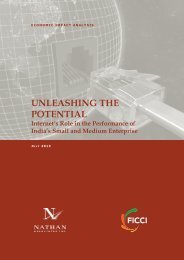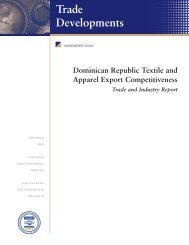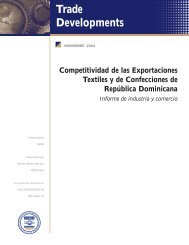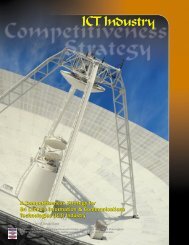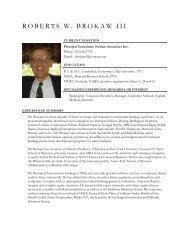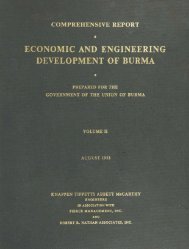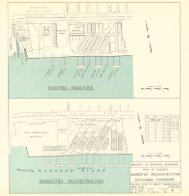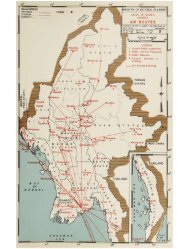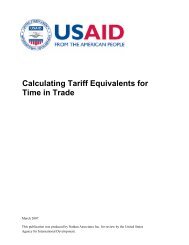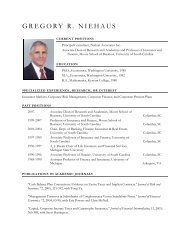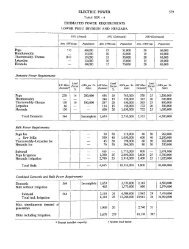Putting it to Work in Developing Countries - Nathan Associates
Putting it to Work in Developing Countries - Nathan Associates
Putting it to Work in Developing Countries - Nathan Associates
Create successful ePaper yourself
Turn your PDF publications into a flip-book with our unique Google optimized e-Paper software.
exped<strong>it</strong>e approvals. Otherwise the approval<br />
process aga<strong>in</strong> becomes bureaucratic and <strong>in</strong>efficient.<br />
19 In short, strategic, carefully planned<br />
streaml<strong>in</strong><strong>in</strong>g of the adm<strong>in</strong>istrative framework for<br />
<strong>in</strong>vestment can benef<strong>it</strong> foreign and domestic<br />
<strong>in</strong>ves<strong>to</strong>rs, but only as an <strong>in</strong>terim measure until<br />
adm<strong>in</strong>istrative barriers can be removed through<br />
full-scale reform and liberalization of the public<br />
sec<strong>to</strong>r. 20<br />
EXPORT PROCESSING ZONES<br />
Nearly every successful export-led growth strategy<br />
<strong>in</strong> Southeast Asia and throughout the develop<strong>in</strong>g<br />
world <strong>in</strong> the past 40 years has started w<strong>it</strong>h<br />
an enclave approach—free trade zones, export<br />
process<strong>in</strong>g zones, bonded warehouses, or special<br />
economic zones, as <strong>in</strong> Ch<strong>in</strong>a. In solv<strong>in</strong>g most<br />
regula<strong>to</strong>ry and other bus<strong>in</strong>ess control problems<br />
<strong>in</strong> a small area, enclaves represent a pol<strong>it</strong>ically<br />
savvy approach yield<strong>in</strong>g good results while<br />
approach<strong>in</strong>g the enormous challenge of economy-wide<br />
reform gradually.<br />
Export process<strong>in</strong>g zones (EPZ) have been particularly<br />
popular. 21 More than 3,000 exist <strong>in</strong> 116<br />
countries and employ 43 million workers, mostly<br />
women. 22 Concentrated <strong>in</strong> textiles, apparel, and<br />
consumer electronics, EPZs have been used <strong>to</strong><br />
stimulate exports of nontrad<strong>it</strong>ional goods, generate<br />
employment, and attract foreign <strong>in</strong>vestment.<br />
EPZs attract foreign direct <strong>in</strong>ves<strong>to</strong>rs through tax<br />
concessions, superior <strong>in</strong>frastructure, reduced<br />
adm<strong>in</strong>istrative barriers, and duty-free import of<br />
components used <strong>in</strong> export production.<br />
EPZs have long been built around manufactur<strong>in</strong>g<br />
goods for export but are now <strong>in</strong>corporat<strong>in</strong>g<br />
services <strong>in</strong> response <strong>to</strong> the upward trend <strong>in</strong> efficiency-seek<strong>in</strong>g<br />
FDI <strong>in</strong> that sec<strong>to</strong>r. In such a<br />
zone, workers may provide data process<strong>in</strong>g or<br />
call center services. ICT <strong>in</strong>frastructure is cr<strong>it</strong>ical<br />
for these zones, as are productive, cost-effective<br />
workers and managers. Trad<strong>it</strong>ional EPZs may<br />
well be useful <strong>in</strong> attract<strong>in</strong>g FDI for many countries,<br />
but the more labor-<strong>in</strong>tensive zones may<br />
decl<strong>in</strong>e <strong>in</strong> importance given the <strong>in</strong>dustry shifts<br />
described <strong>in</strong> Chapter 4. In add<strong>it</strong>ion, the export<br />
subsidies that are the heart of EPZ operations<br />
have been questioned s<strong>in</strong>ce 1995 as possibly violat<strong>in</strong>g<br />
WTO agreements, depend<strong>in</strong>g on the hostcountry’s<br />
<strong>in</strong>come level. This is likely <strong>to</strong> discourage<br />
some future EPZ activ<strong>it</strong>ies (Exhib<strong>it</strong> 5-4). 23<br />
In sum, EPZs have helped generate employment<br />
and launch <strong>in</strong>dustrialization <strong>in</strong> difficult economic<br />
environments. But their enclave nature may<br />
tend <strong>to</strong> isolate benef<strong>it</strong>s. EPZs need <strong>to</strong> be l<strong>in</strong>ked<br />
<strong>to</strong> the general economy’s <strong>in</strong>dustrial and commercial<br />
centers and <strong>to</strong> a well-educated workforce<br />
<strong>to</strong> facil<strong>it</strong>ate the spillovers and technology transfers<br />
that motivate the pursu<strong>it</strong> of FDI. 24<br />
INCENTIVES<br />
Most develop<strong>in</strong>g and developed countries alike<br />
provide <strong>in</strong>centives for FDI. The most common<br />
are fiscal—tax holidays, special tax reductions<br />
and the like. 25 Others <strong>in</strong>clude grants and subsidies<br />
and construction of special <strong>in</strong>frastructure.<br />
These <strong>in</strong>centives are justified on the basis of the<br />
direct and <strong>in</strong>direct benef<strong>it</strong>s of FDI and the hope<br />
of creat<strong>in</strong>g <strong>in</strong>dustrial agglomerations or clusters<br />
of foreign firms that can accelerate development<br />
and attract more <strong>in</strong>vestment. But the tradeoff<br />
can be costly. For example, <strong>in</strong>centives offered<br />
au<strong>to</strong>mobile manufacturers <strong>in</strong> Central Europe<br />
amounted <strong>to</strong> more than $200,000 for each job<br />
eventually created. 26 When <strong>in</strong>centives <strong>in</strong>clude<br />
cash subsidies and outlays for <strong>in</strong>frastructure, or<br />
other f<strong>in</strong>ancial <strong>in</strong>centives, the price can rise rapidly.<br />
And, whatever their benef<strong>it</strong>, such <strong>in</strong>centives<br />
create economic dis<strong>to</strong>rtions and <strong>in</strong>efficiencies<br />
that work aga<strong>in</strong>st local firms that do not qualify<br />
for them.<br />
Given these costs, are <strong>in</strong>centives an effective way<br />
<strong>to</strong> attract FDI At least accord<strong>in</strong>g <strong>to</strong> conventional<br />
wisdom, tax <strong>in</strong>centives—<strong>in</strong> Ireland, Malaysia,<br />
Costa Rica, and Maur<strong>it</strong>ius—seem <strong>to</strong> have stimulated<br />
FDI. 27 But many mult<strong>in</strong>ationals rate a<br />
stable and predictable tax regime as more cr<strong>it</strong>ical.<br />
28 All th<strong>in</strong>gs be<strong>in</strong>g equal, tax <strong>in</strong>centives may<br />
marg<strong>in</strong>ally affect location decisions for efficiency-seek<strong>in</strong>g,<br />
export-oriented FDI projects. 29 Their<br />
<strong>in</strong>fluence on market-seek<strong>in</strong>g FDI may be even<br />
less significant.<br />
64



